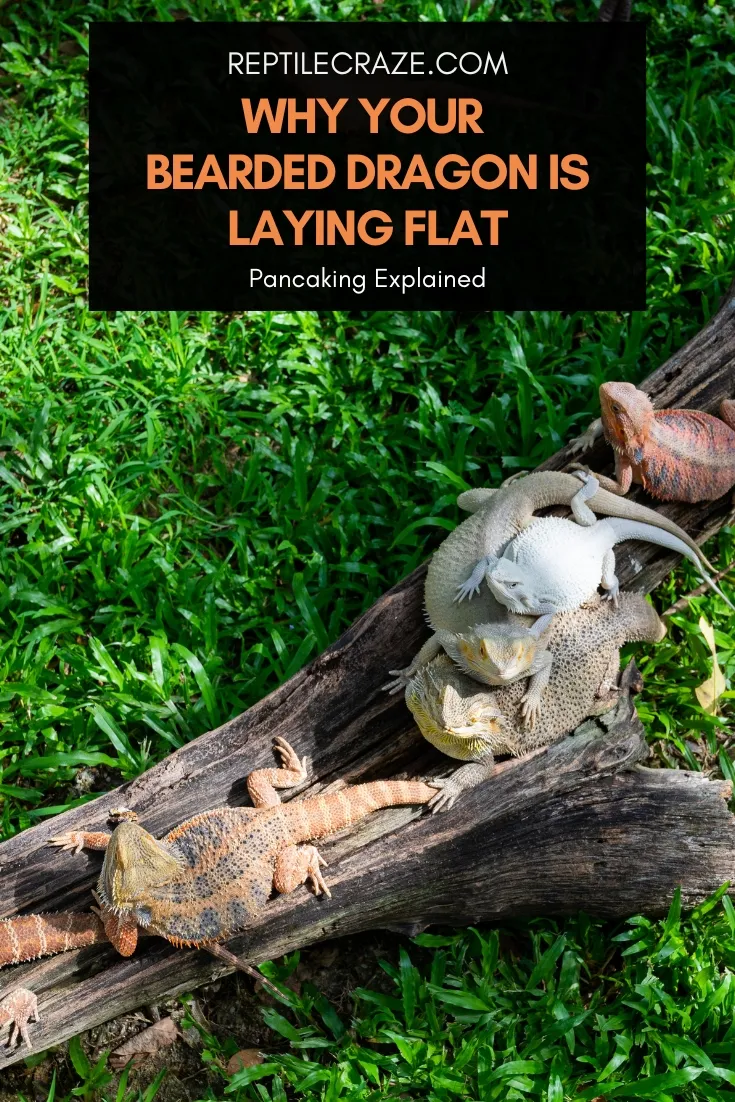
Have you seen your bearded dragon laying flat in its enclosure? What does this behavior mean? Is laying flat the same as pancaking? Seeing your bearded dragon laying flat for an extended time may be concerning, but first, you have to determine if it is normal or abnormal behavior.
Bearded dragons lay flat or pancake when they need to increase their body temperature. Pancaking is also a sign that your bearded dragon has an illness. Further, it can be a defense mechanism that is related to stress.
In this article, we are going to talk about bearded dragon pancaking behavior. We will also answer your questions about certain body language that comes with pancaking. So read on to find out why your bearded dragon is laying flat!
Table of Contents
What Is Pancaking In Bearded Dragons?
Pancaking is the term used for the body language of bearded dragons that are characterized by laying flat on the ground and sometimes, their side spikes also become stiff.
In doing so, their bellies look larger than they are and they appear to be bigger.
When bearded dragons lay flat on the ground, they also appear like they are stuck and unable to move. However, this is not the case as beardies can still move slowly while they are laying flat.
Reasons Why Bearded Dragons Lay Flat
It is comforting to know that pancaking in bearded dragons does not equate to a life-threatening situation.
However, when this behavior is seen, it usually requires the owner to make adjustments in the enclosure or give the owner a clue about an impending illness.
On the other hand, it is still highly possible that pancaking is still normal behavior that is just a reaction to certain stressors in the environment. In this case, you can determine the stressor and remove it to calm your bearded dragon.
Here are the reasons why your bearded dragon is pancaking.
1. Bearded Dragon Needs To Increase Its Body Temperature
Your bearded dragon may lay flat on the ground or on its basking spot in an effort to rapidly increase its body temperature.
When they do so, the other parts of their body that do not usually get exposed directly to the UV rays get more exposure, thus hastening the rise in their temperature.
This can happen when your bearded dragon just had a full meal and it needs to digest properly. Keep in mind, beardies need external heat to digest, thus if they had a heavy meal they need more heat to aid in digestion.
You may also notice that when your bearded dragon does this, their beards will turn a darker color. They will also close their eyes while doing so. As it digests, its color will go back to normal and it will also assume a normal posture.
On the other hand, if you see that your beardie is still pancaking and dark in color the next day or 48 hours after its meal, then it is not doing this behavior to digest properly.
It means that the
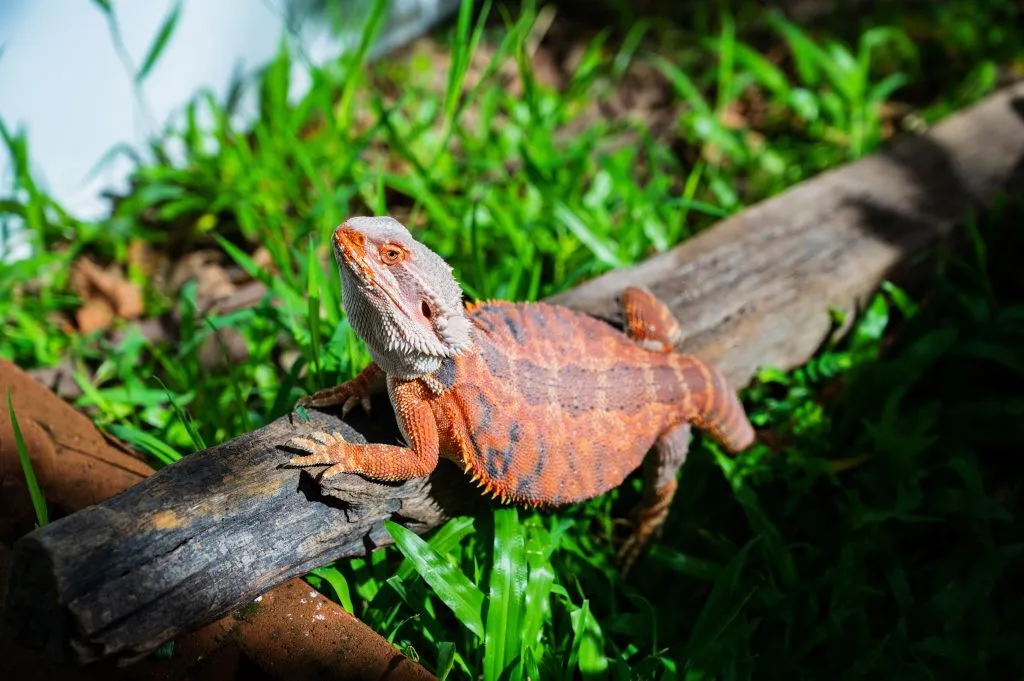
You have to make sure that the basking temperature is between 108-113 F. At the same time, it is possible that the basking spot is not in the right area.
You can use a UVI meter just like this one to know where you should place the basking spot of your beardie.
The basking spot of your beardie should have a UVI between 2.9-7.4. A UVI meter can help in knowing if a certain spot is within those bounds which will be the perfect basking spot.
Why Is My Bearded Dragon Laying Flat In The Morning?
Pancaking in the morning is also related to increasing their body temperature rapidly. This happens as during the night, they are exposed to lower temperatures.
During the last stretch of the “lights off” time of your beardie, the temperature of the
But as the temperature dips to the lower ranges, your beardie is inclined to get more heat in the morning when the lights are turned on.
You do not have to do anything as this is normal and it actually fosters their natural body thermoregulation. Just make sure that the temperature at night does not go below 65 F.
You can read our guide on heating your beardie tank at night to make sure you do not underheat the
Why Is My Bearded Dragon Pancaking When It Is Outside?
Your bearded dragon may lay flat while it is in your backyard or when you are taking it out for a walk as it feels cold.
When it does this, you should not leave it outside too long as the temperature outside can easily change, and your beardie can no longer thermoregulate properly.
In order to avoid this, you should not take your beardie outside during fall and winter.
Additionally, you should take them out when the sun is shining at its brightest, which is around 12 noon-2 pm to make sure that there will be no sudden change in temperature.
2. Bearded Dragon Has An Illness
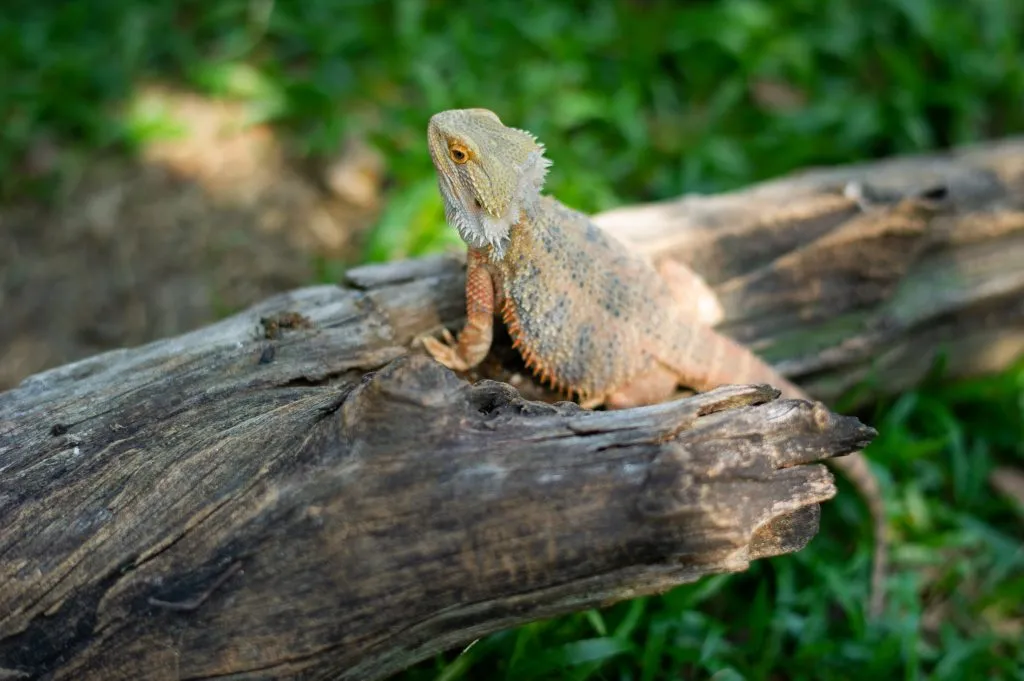
A concerning reason why your bearded dragon is pancaking is that it is suffering from an illness. Your bearded dragon may lay flat as it is experiencing pain due to digestion issues.
It can be impacted, constipated, or about to have diarrhea.
If your bearded dragon has been refusing food and it is pancaking while its head is down, this can be a sign of dehydration.
You need to rehydrate your beardie if it is not yet a severe case, but you can also contact your vet as it might need to undergo fluid therapy.
If you also notice your bearded dragon closing its eyes while pancaking, it may also be a sign of a parasitic infection.
In this case, you really need to make a trip to the vet. You can check out this article to learn about other reasons why your beardie is closing its eyes.
Another reason for pancaking that is related to an illness is when there is a calcium imbalance.
It is possible that there is a lack of calcium or the calcium was not properly absorbed in the body which leads to Metabolic Bone Disease (MBD).
Usually, when this is the case, your bearded dragon will be pancaking while its legs are straightened out. This is a sign that their legs are slowly losing their mobility due to MBD.
You should not mistake this with a pancaking beardie with legs straight out while it is basking as this is normal behavior.
When they do this while basking, they are simply stretching. Compared to the MBD case, where the legs are stiffly straightened out.
Tip: Also, if your bearded dragon appears to be sick, read this article!
3. Bearded Dragon Is Being Defensive
It is also possible that your bearded dragon is pancaking because it is stressed. Stress can be caused by many factors, but in the wild, bearded dragons lay flat on the ground as a way of hiding from bigger predators.
Usually, when bearded dragons feel threatened and they feel the need to defend themselves, they puff up and bob their beads to assert their dominance and look more intimidating.
However, there are times that they will also lay flat to look bigger to scare away potential predators.
More often than not, they do pancaking when they are stressed due to fear. Here are the situations where your beardie will lay flat due to stress.
Bearded Dragon Is Scared Of Other Pets
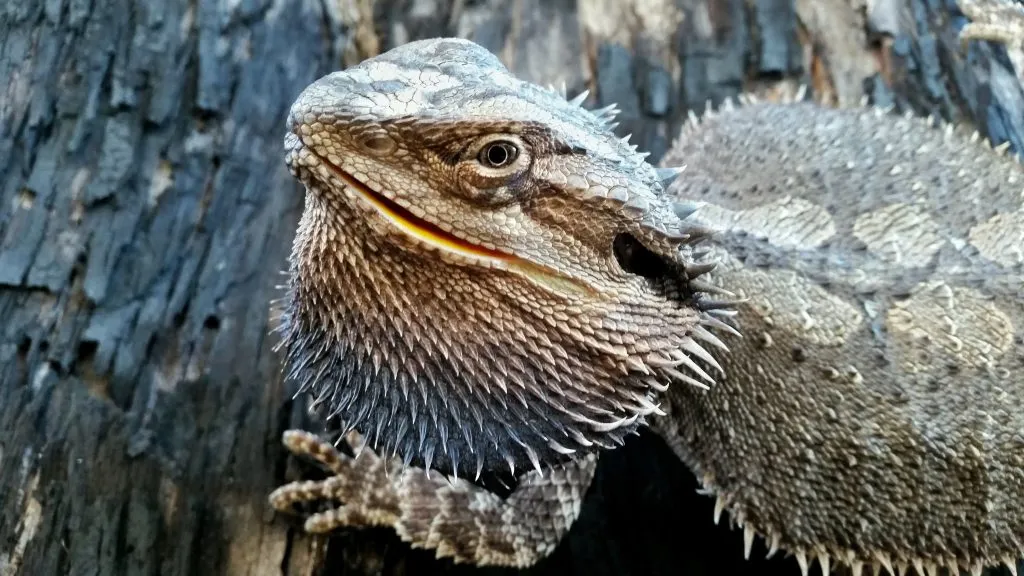
If you have other pets in the household like dogs, cats, or other reptiles, your beardie may see them as a threat. It is not always that they pancake when they see other pets, rather they puff up.
Pancaking in this case usually happens when you take out your beardie and expose them to your other pets.
There are owners who observed that their beardies do pancaking behavior when the
Even if this is considered as normal behavior, you should not let your beardie get stressed too much as it may become ill.
It is best to not let your other pets bother the
It is also a good thing to not place the
A car that is passing by can be construed as a predator by your beardie, and it will keep pancaking without fail, which is unhealthy.
Bearded Dragon Is Scared Of You
There are also rare cases where a bearded dragon will lay flat instead of puffing up when you approach the cage. This means that your beardie sees you as a predator.
You need to be patient with bonding with your beardie as it takes a long time to earn its trust. Once you succeed with hand feeding, and it no longer puffs up or pancakes upon your presence, then you can move on to handling training.
In the video below, pancaking is displayed by a scared bearded dragon that is ready to be handled.
The tip of the owner is to let your beardie overcome its fear and make sure that you handle your beardie from below and not from above as your beardie will get more scared if you do the latter.
Bearded Dragon Is Scared Of New Things In The Tank
Your bearded dragon may also lay flat with the new additions to its
Even if you purchased these things for the benefit of your beardie, it may be stressed over these new things as they are unfamiliar.
If you notice that your beardie is still pancaking even after a week of exposure to the new ornaments, it means that it will not get used to it.
It is better to remove those things from the
Do Bearded Dragons Lay Flat When Sleeping?
Bearded dragons do not usually lay flat when they are sleeping, instead, they just lay on their bellies but do not flatten them.
If you notice your beardie pancaking in its sleep, it is possible that it is not getting enough heat at night.
If this is the case, you can consider providing it with a ceramic heat emitter just like this one. The ceramic heat emitter does not emit light so it will not disturb your beardie’s sleep.
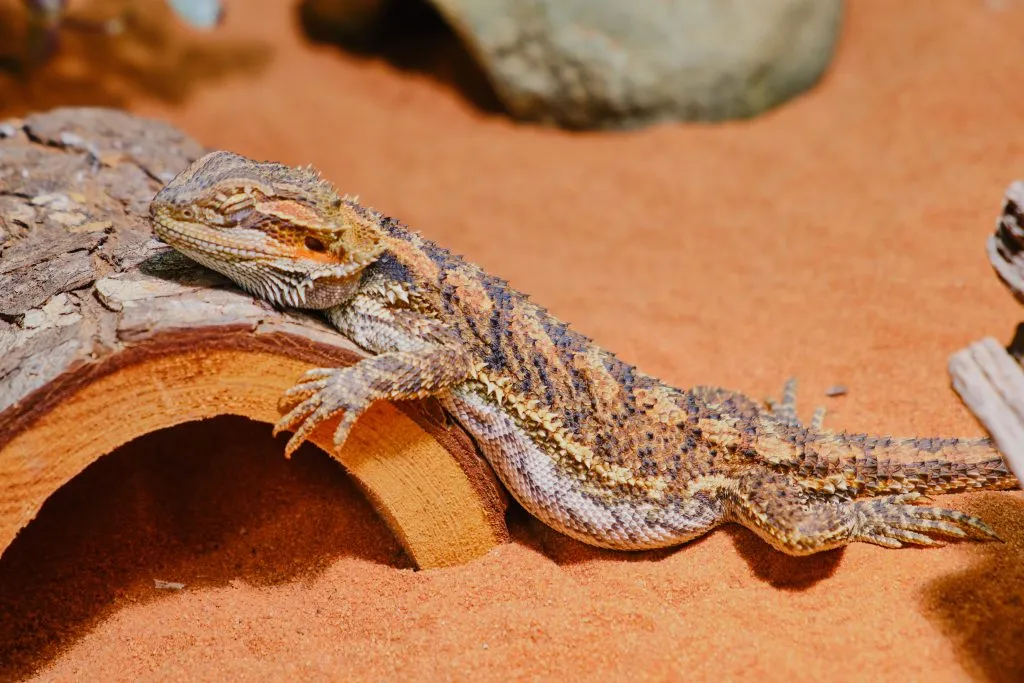
Why Is My Bearded Dragon Laying Flat In The Corner?
If your bearded dragon is laying flat in the corner and it is not moving for an extended period of time, it can be a sign of illness or immense stress.
This is definitely not a temperature issue because if this is the case, then your beardie should pancake directly under the basking light or on its basking spot.
It is not normal for a bearded dragon to lay flat in a corner and not move. You have to check the enclosure immediately if anything is stressing your beardie and remove that thing.
On the other hand, if you cannot see any stressors inside or outside the enclosure, and the pancaking is still ongoing, you need to check with your vet to rule out illnesses.
Pancaking And Sexy Legs In Bearded Dragons
If you see your bearded dragon pancaking with one or two of its hind legs straightened out, you may think that it is injured, especially if its legs are hanging off the basking spot.
No need to fret! This is called “sexy legs.” This happens when your beardie also wants to expose its legs to UV rays to get more heat.
It does not necessarily mean that your beardie is cold or underheated, it is simply enjoying its basking time. In fact, your beardie is most relaxed during this time.
Conclusion
Bearded dragons lay flat when they need to increase their body temperature, if they have an illness, or if they are stressed.
When you see a pancaking bearded dragon, always check the
If you suspect that pancaking is brought about by an illness, make sure that your beardie does not get dehydrated, and contact your vet to get some advice on what steps to take.
- Enchi Ball Python: A Unique and Stunning Morph of Python regius - March 27, 2025
- Emerald Tree Monitor: The Enigmatic Green Guardian of the Rainforest - March 26, 2025
- The Egyptian Cobra (Naja haje): A Fascinating Serpent - March 25, 2025
